
Station Name: WARBOYS[Source:
Nick Catford]
Warboys Gallery 1: c1907 - Early 1960s old10.jpg) A reasonably busy scene at Warboys in Great Eastern days and sometime after 1906. The intending passengers are waiting for a Ramsey-bound train and the number of baskets and other items on the platform might suggest that it is market day at Ramsey. The station had a mix of oil and gas lighting at this time, surprisingly given the station's somewhat isolated location. Gas was presumably supplied from Ramsey gasworks, which stood opposite Ramsey North station. Warboys brickworks generated its own electricity from 1917 but may also have had a gas supply; if so, this would explain the economics of its presence on the railway station. There are plenty of photographs of Warboys station, the majority taken after closure to passengers, but not many show the signal box. The box was effectively redundant after 1930 and is believed to have been abolished in 1932; it had disappeared by the 1950s. Note the grounded van body in use as a shed. It is an ex-GER outside framed van. Another van body used for the same purpose could be found at Ramsey East albeit of a different type. At extreme left can be seen part of a gable-ended building. This building was nothing to do with the railway and is thought to have been connected with the brickworks, perhaps a manager or foreman's house. Note the running-in board on the left. One of the two boards has survived and is now on display at Kidderminster station,
Severn Valley Railway. Photo from John Mann collection 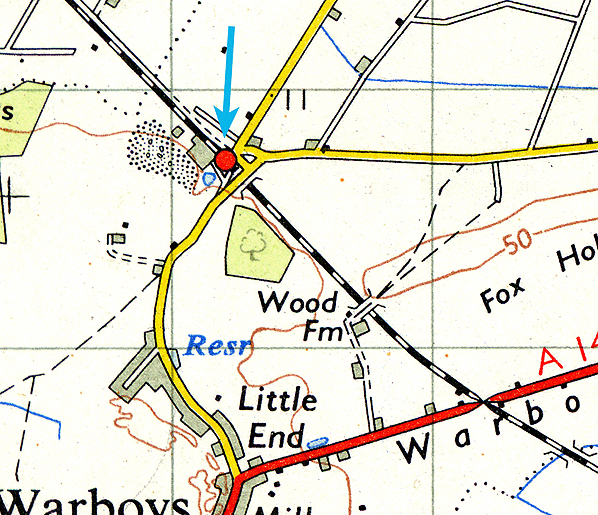 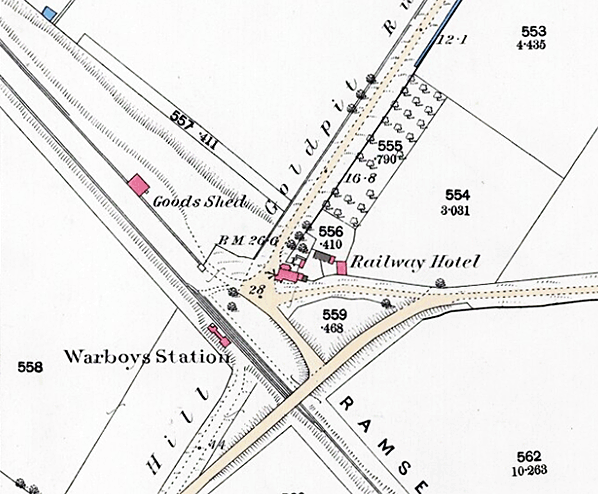
Warboys station as shown on an 1888 1.2,500 OS map. The survey for this map wad made 1887, two years before the line opened. The passenger building is shown, as is the goods shed and a single siding which has yet to be joined to the running line. The Railway Hotel is already open for business, two years before it would receive any customers from the railway other than navvies working on the line. The adjacent brickworks has not yet been built; it opened in 1891.
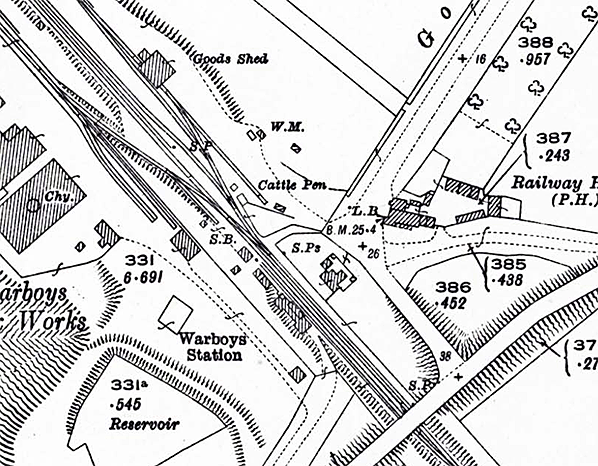 A 1926 OS 1:2500 map. The station building is seen on the down side at the end of an approach road; there are no buildings on the opposite platform. Access to the goods yard and brickworks sidings was controlled by the signal box (SB) at the north end of the down platform. The goods yard is entirely on the up side with all the sidings on the down side serving the brickworks. Access to the goods yard is along a short, wide approach road opposite the Railway Hotel. Halfway between the road and the goods shed is the weighbridge and adjacent weigh office (WM). One siding runs from the loop passing the small cattle dock before splitting with one line running parallel to the main line with the other running towards the goods shed where it splits again with one line running through the goods shed and another alongside it on the south side. Another short siding trails back to the rear of the cattle dock. Beyond the diamond crossing at the end of the loop another siding runs parallel to the main line. The stationmaster's house is seen at the rear of the up platform. Click here to see a larger version
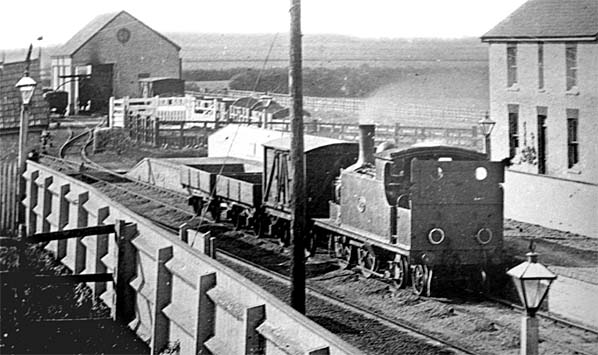
An Adams class 61 0-4-4T is seen shunting at the north end of Warboys station in 1910. These were Liverpool Street suburban locos, later given modified cabs as seen here, after which they were used on rural services. They had all gone by 1913. The stationmaster's house is seen on the right. The white fencing is the cattle pen which is standing on the small dock alongside the siding.
old11.jpg) Stationmaster Charles Swannell at Warboys around the time of the withdrawal of passenger services in 1930. This is one of two known photographs of Mr Swannell on his station and with his dog. The stationmaster's house was at the rear of the up platform, behind the photographer. What the bundles are is not known but they appear to be rolled-up sacks of some description. In the window to the left of Mr Swannell ,and apparently about to fall down, is a poster advertising excursions to London and, under magnification, Cambridge also appears to be mentioned. The partly obscured advertisement on the left was for Bovril and one of a range of advertisements for Bovril presented as a proverb. A common one advised 'It is never too late for Bovril' and this one appears to be a variation of that theme and possibly said 'It's never too late to send - for Bovril' and if so would have been aimed at people with domestic staff. There was once a vast range of Bovril advertisements, many being typical of the time with plenty of colour and homely scenes. Some were, like many others of the time, rather cheeky and one such showed The Pope sitting drinking a cup of Bovril. Other points of note are the Warboys nameplate on the bench and the clinker-surfaced platform but with stone edging. Both platforms at Warboys appear to have been in this form for their entire existence, unsurprising given the early closure date. Returning to the stationmaster, Swannell was and is a familiar name in the Warboys area so if any readers have any information on Charles we would be pleased to be able to say a little more about him.
old12.jpg)
A Somersham-bound passenger train stands at Warboys around the time of withdrawal of passenger services in 1930. On the right is the stationmaster's house with its own access to the platform and the gentleman with his hands on his hips may be Mr Swannell, the stationmaster at the time. The clinker-surfaced platform can be seen and just visible is a Warboys nameplate on the bench seat. This photograph contains two interesting features, the first being the shunt signals with ringed arms. These were once common and used by several railway companies. The siting of these signals (at Warboys) was a little odd and precisely what they controlled is unclear. We must thank whoever opened the carriage door for revealing the second interesting feature. The rounded top to the door, Metropolitan Railway fashion, tells us the carriage was one of batch introduced by Holden in 1898 and known by the GER as Type 9. Built for London suburban services they were 27ft x 9ft 4-wheelers and came in four types; 4-compartment 1st, 5-compartment 2nd, 5-compartment 3rd and 2 compartment brake 3rd. The first batches built 1898-99 had flitched wood underframes and were among the very last to be so-built. Seating was six-aside, apparently including in the 1st class vehicles, while doors were recessed to keep the handles within the restricted loading gauge. Another oddity, at least to modern eyes, was the body panelling. Bodywork was wooden but with steel panels over the waistband recesses and doors while the rest of the body exterior was teak faced. These carriages, which totalled 601 with production of the final batch in 1905, were eventually displaced from suburban work and shuffled off to rural areas or into departmental service or withdrawn. Quite how many of these carriages were in the train at Warboys cannot be determined but that nearest the camera is clearly of a different type.
old3.jpg) Warboys station looking north in August 1952, 22 years after closure to passengers. The brickworks are seen on the left. The stationmaster's house is seen on the right with the goods shed partly obscured by a tree. The up platform never had any buildings and quickly became overgrown since it
was not used after 1930. Copyright photo from John Alsop collection old9.jpg)
An aerial view of Warboys station in June 1953 looking in the Somersham direction. At the top of the An aerial view of Warboys station in June 1953 looking in the Somersham direction. At the top of the picture is Puddock Hill while towards top left is the stationmaster's house and to its left can be seen part of the driveway to the Station Hotel. It is clear from this view how the original road was curtailed and diverted over the bridge when the railway was constructed. Just above centre left is the weighbridge and associated weigh office contained the scales. The road passing the weighbridge is the entrance to the goods yard. Almost opposite the weighbridge is the cattle pen; note the siding leading to it from the goods shed which is overgrown and all but invisible. The goods shed has the typical arrangement for a rural location of one track passing through it with another avoiding it. The up platform would be difficult to discern were it not for its ramp but the down platform with station building is more obvious. One feature conspicuous by its absence is the signal box. This had stood at the Ramsey end of the down platform and is believed to have been abolished in the 1930s. The pointwork with diamond crossing between platforms and locomotive, which appears to be a J17, was removed following closure of the line onwards to Ramsey. Thereafter access to the up platform road was via the reverse curve on the left. Re-sleepering work is ongoing and this may explain the presence of at least some of the open wagons. Right of centre the rather overgrown brickworks sidings can be seen. By this date incoming traffic would have been occasional fuel deliveries but outgoing products would by this time have largely, if not totally, switched to road transport. Nevertheless it is interesting to speculate on whether the stacks of what appear to be hollow clay bricks are awaiting loading into railway wagons. The sidings remained officially in use until the line closed permanently in 1964. The lorry, probably belonging to London Brick, on the right is too far away to be identified but it does have a look of Atkinson about it. Steam locomotives remained a regular sight at Warboys until the late summer of 1962 and then intermittently until March shed closed to steam in 1963. Diesel traction was almost always a Brush Type 2 with other types making rare appearances. Click here for a larger version.
Reproduced with the kind permission of Simmons Aerofilms Ltd old15.jpg)
Another excellent aerial view of Warboys station in June 1953. The Puddock Hill bridge is seen top right and below it the access road both to the station and the brickworks. From this angle the slight slope in the roof of the middle section of the station building s clearly visible. The house to the right of the station building (now called Wingate) was built at the same time as the brickworks so is likely to have been for the manager. The Railway Hotel is seen top centre opposite the entrance to the goods yard. Along the approach road to the goods yard, the cattle pen, standing on an unusually small dock, is seen on the left with the weighbridge and weigh office on the right. Beyond that is the goods shed with one siding running through it, another alongside and two more parallel. The J17 is still in the siding. One of the brickworks’ two Hoffmann kilns is seen in the centre with the clay pit at the rear. A 1ft 11½in narrow gauge line is seen running along the edge of the pit, over a bridge and into one of the buildings. The brickworks had two Simplex (Motor Rail & Tramcar Co, Bedford) diesel locomotives.
Click here for a larger version. Reproduced with the kind permission of Simmons Aerofilms Ltd 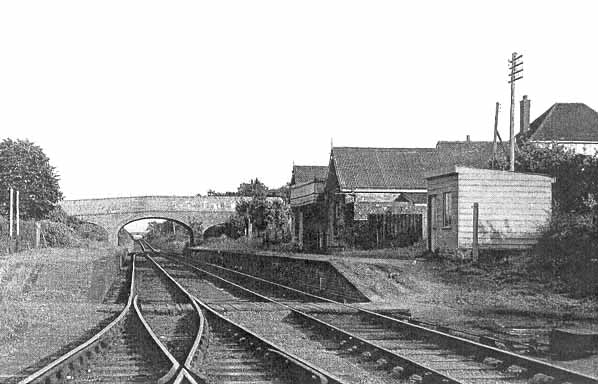
Warboys station looking south in 1954. The station building, as can be seen in one of the pictures above, originally had a tiled roof. The tiles have now been replaced with corrugated metal sheets. The posts for the station's two running-in boards can be seen, that for the down platform is just visible amongst the bushes while that for the up platform is clearly seen on the left. The house on the far right is nothing to do with the railway and was built at the same time as the brickworks, perhaps for the manager. The house (now called Wingate) is still standing today; it may have been the brickworks manager's house.
Photo from Stations UK 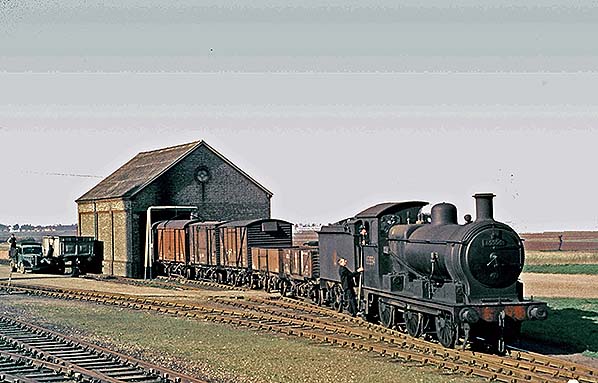
Class J17 0-6-0 No.65554 shunts Warboys goods shed. The date is the first half of 1961 as No.65554 was transferred from March to Stratford in June of that year. Seen here is a rake of vacuum-fitted wagons but No.65554 is not so-fitted. Seventeen members of the class were, however, fitted to work passenger trains over the M&GN system in 1942 but were displaced following nationalisation and could then be seen anywhere on the former GER system. The shunter perched on the side of the locomotive is complete with pole for coupling and uncoupling wagons. There was a knack to this job and which was acquired with experience. Adjacent to the goods shed is a single non-fitted coal wagon being unloaded into a once-ubiquitous Bedford lorry. If the wagon were fully loaded, lorries such as this would need to make several trips in order to empty the wagon completely. Notwithstanding lorries of the time being relatively small compared to those of today, this view illustrates well the true size of railway wagons normally seen only from a distance or 'cut in half' by station platforms. The Holden J17 class originated as rebuilds of the J16 class which had totalled sixty examples. All the J17s passed into British Railways ownership with one exception. The ninety class members were numbered by BR as 65500 - 65589 but with a conspicuous gap which should have been filled by No.65550. The class underwent several re-numberings over the years and that which had become LNER No.8200 would have taken the number 5550 under the LNER 1946 renumbering scheme. However this locomotive was withdrawn in 1944 after sustaining damage during a V2 rocket attack. BR Eastern Region renumbered the class by the simple expedient of adding a '6' to the LNER numbers and thus there never was a BR No.65550. With the exception of No.65567 which survived into preservation the class became extinct in September 1962 with No.65554 herself going in September 1961, not long after her move to Stratford.
Photo by John Carter 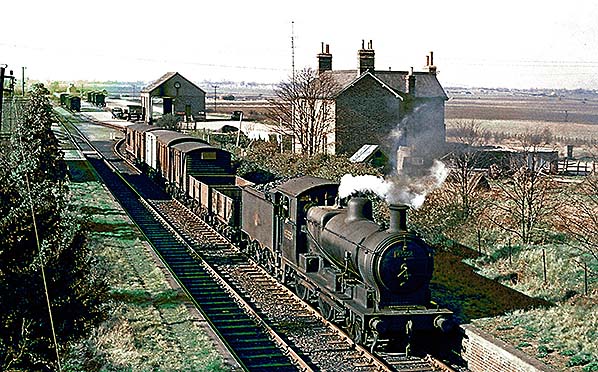
Here is No.65554 again and on the same day as the previous view. She has completed her shunting and is ready to head back to Somersham. In 1961 the working of the Warboys goods was a somewhat odd affair as far as the working timetable was concerned. The train ran Monday - Friday and departed March (Whitemoor) at 11.55am and shunted Wimblington and Chatteris before arriving at Somersham where it effectively terminated at 1.29pm. The Somersham - Warboys goods was treated as a separate trip working, albeit operated by the same locomotive and crew. At Somersham any wagons for Warboys would then be detached, with the rest of the train left in the sidings, and tripped down the branch. Alternatively, if there were no wagons for Warboys but there were wagons at Warboys awaiting collection the locomotive would head along the branch with a brake van. Level crossings en route were operated by the train crew. There was also a public siding at Pidley (full title Pidley-cum-Fenton but usually referred to as simply 'Pidley'), 2m 20ch from Somersham, used by farmers, but in later years it was rarely used. The points Pidley siding faced Somersham so any wagons for the siding were taken through to Warboys and reversed into the siding on the return journey. Shunting on the branch completed, the Warboys goods would then return to Somersham where the locomotive would run round, collect wagons which it had left there earlier, place the brake van on the rear of the train and return to March, arriving around 5pm. Timings for the Warboys goods in 1961 were: Somersham dep. 1.55pm; Warboys arr. 2.15pm; Warboys dep. 2.55pm; Pidley siding served as required but untimed; Somersham arr. 3.28pm. Following the necessary shunting at Somersham the train would depart for Whitemoor at 3.55pm. As can be seen, 40 minutes were allowed for shunting at Warboys and on the rare occasions traffic was busy this could be quite tight. On odd occasions there were no wagons for or from Warboys and in these circumstances the train would not run, simply returning to March from Somersham around 2pm. As mentioned, Pidley siding was served if required on the return journey to Somersham but with no specific timing. However and as the timetable shows, 13 minutes were allowed but as Pidley siding was rarely used early running was commonplace. As No.65554 prepares to leave Warboys, a number of further wagons remain in the siding for unloading and/or loading and these will be collected another day. This views shows the track alterations which had occurred following closure of the section to Ramsey in 1956. This closure was not absolute, however, as the line beyond Warboys including Ramsey station was used for several more years for storing wagons - a common occurrence on otherwise disused lines and particularly in East Anglia where wagon requirements tended to vary according to season. The track beyond Warboys was finally removed around the time this photograph was taken. On the left and in the extreme background a signal is in situ, probably a fixed distant. Beyond the end of the down platform, on the left, the spur serving Warboys brickworks can be seen. It ran more-or-less parallel to the running line but is largely obscured by vegetation in this view. The siding remained in use until
closure of the branch. Photo by John Carter old13.jpg) Warboys station looking north from the down platform circa early 1960s. A walkway has been maintained along the platform while the up platform is now so heavily overgrown that it is impassable. The pointwork and crossing at the end of the platforms was removed in 1956 when the line to Ramsey closed completely. A single wagon is noted alongside the goods shed. Warboys station looking north from the down platform circa early 1960s. A walkway has been maintained along the platform while the up platform is now so heavily overgrown that it is impassable. The pointwork and crossing at the end of the platforms was removed in 1956 when the line to Ramsey closed completely. A single wagon is noted alongside the goods shed.Photo from John Mann collection Click here for Warboys Gallery 2:  Home Page Home Page
|



